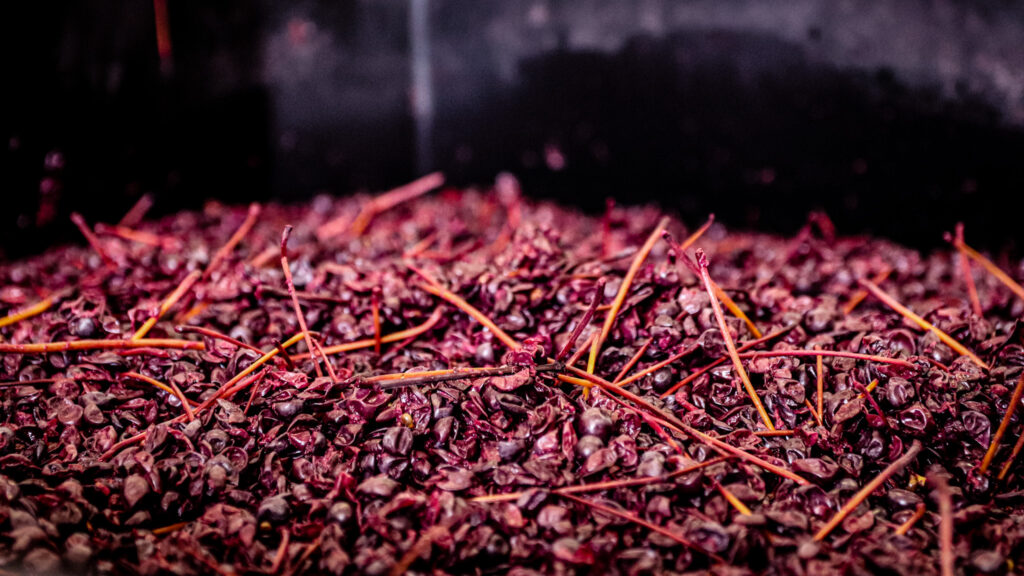
Headline-writers love to tout the healthiness of red wine. Here’s how it goes: a scientific study about a specific food compound — such as flavonoids — gets published. The findings support that the compound has health benefits. That compound happens to be found in red wine, as well as many other foods. But we all know that lifestyle publications often lead with the red wine information in the headline.
It makes sense from a getting-eyes-on-the-page point of view. More people will be interested in reading about the heart benefits of red wine than the heart benefits of red cabbage. Those articles eventually mention the other foods with the healthy compound and also inform readers that red wine, because of its alcohol, should be consumed in moderation.
What if, however, the healthy compounds in red wine didn’t have to be consumed in moderation? What if they could be extracted, concentrated and used as a supplement or a food additive for humans and animals?
A team at Cornell University is looking at just that. Led by Elad Tako, associate professor of food science in the College of Agriculture and Life Sciences, they’re studying grape pomace, the leftovers of pressed grapes, for its nutrients and how those nutrients may benefit intestinal health. The early findings are promising.
The Study
In their research, Tako and his research team focus on how plant origin bioactive compounds affect intestinal functionality, morphology (the tissue phenol type), and the microbiome.
For this particular study, they used pomace from Cabernet Franc, Noiret and Concord grapes — purposefully choosing a Vitis vinifera, an interspecific hybrid, and a Vitis labrusca — grown in Cornell’s own vineyards. The team set out to determine how the bioactive compounds in grape pulp affect intestinal functionality, Tako explains.
“As a food scientist, I am always trying to find the next potential bioactive compound that we can potentially incorporate into a food product,” says Tako. “Where is it coming from and what would be the best way to either extract it from the source or use the source itself? With grape pomace, we can potentially do both.”
To determine if bioactives from grape pomace might eventually be incorporated into food products that could boost the health of those consuming them, the scientists studied two stilbenes (phenolic compounds), resveratrol and pterostilbene, found in high concentration in grape pulp.
Using a poultry model, the study was done on the embryonic phase of chickens.
“The embryonic phase lasts for 21 days and the embryo is surrounded by multiple compartments,” says Tako. One of those compartments is the embryonic fluid. That fluid is naturally and orally consumed by the embryo starting on day 17 of incubation, signaling to the embryo that the gastrointestinal tract needs to wake up because it’s about to hatch.
“We introduce the nutritional solution in question into the embryonic fluid on day 17 of embryonic incubation,” Tako says. “By day 19 of incubation, it’s completely gone.”
When the embryos hatch, the scientists collect their samples.
The team conducted three separate experiments: one that simultaneously introduced both stilbenes to the embryos, one that introduced just resveratrol, and one that introduced just pterostilbene.
The Findings
“In the case of grape pomace, we know that they are very rich in polyphenols, particularly the stilbenes, so we were able to demonstrate the nutritional value that they have and how they beneficially affect intestinal functionality,” says Tako.
The study — published as “Modifications in the Intestinal Functionality, Morphology and Microbiome Following Intra-Amniotic Administration (Gallus gallus) of Grape (Vitis vinifera) Stilbenes (Resveratrol and Pterostilbene)” — found there were positive effects on the small intestine and on the intestinal microbiome.
The primary purpose of the study was to look at how the stilbenes from the grape pomace affected intestinal functionality. However, if (after further study) it is shown that nutritional products for human or animal consumption can come from the pomace, there may be benefits for both the environment and for the grape growing industry.
The Sustainability
“Pomace is a significant environmental concern,” says Tako. All of that by-product from winemaking must end up somewhere.
Using pomace to make grappa or piquette can give it a second life, but after those wine-adjacent beverages are produced, the solid pomace still exists. Some wineries compost their pomace, turning it into fertilizer for their vineyards. Some growers sell their pomace as animal feed. But, some of it ends up in landfills, rotting and releasing methane, a greenhouse gas. If pomace can be turned into nutritional supplements and additives, it will keep some of it out of landfills.
The Benefits to Grape Growers
The potential products could be a “win-win situation for the food industry and also for growers and wineries that are trying to find a solution for this by-product,” says Tako. He’s already working on potential ways to create products.
“We’re trying to figure out what would be the best way to introduce pomace into food in what form and in what way. It’s a combination of the form and also a way that will make it most effective in terms of the compound’s bioavailability,” he says.
If Tako and his team can get to the point where they can be sure the pomace can be used to improve intestinal health and in what form it does so, growers and wineries will potentially be able to sell their pomace, creating an additional source of income for their businesses.

